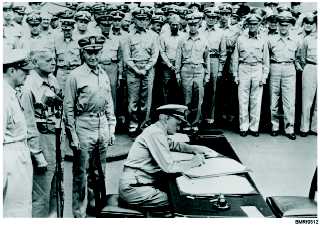Possibly the most versatile of the many new types of
ships built during World War II were the destroyer
escorts, now called frigates. Other types built during
that time included attack cargo ships, transports,
barracks ships, net tenders, repair ships, radar pickets,
minelayers, and mine sweepers. Those ships, as well as
many other types of ships too numerous to mention,
changed the shape of the U.S. Navy almost overnight.
When the Japanese attacked Pearl Harbor,
111 American submarines were in commission, 60 in
the Atlantic Fleet and 51 in the Pacific. After the
invasion of North Africa, U.S. efforts were concentrated
in the Pacific, leaving submarine operations in the
Atlantic to U.S. Allies. The Pacific became the hunting
grounds for American submarine forces.
The number of American submarines during the
war peaked at 247. During the war, the United States
lost 52 of these boats along with 3,505 submariners. The
number of vessels sunk by U.S. submarines played a
major part in the American victory in World War II.
American submarines sank 1,750 Japanese merchant
ships and more than 200 combatants. Those vessels
represented 55 percent of the total Japanese tonnage
sunk in the war. For an island nation such as Japan, those
figures represented a fatal impact.
Radar and sonar came into full use during World War
II. The English used them initially to combat German
U-boats, but they were also incorporated into the
submarine as an attack aid. Sonar has become the most
important of the submarine’s senses. Hydrophones listen
for sounds from other ships and the echoes of sound
waves transmitted from the submarine itself.
Women in the Navy
Twenty-one years after the Yeomanette era,
women were needed to fill an acute shortage of
personnel caused by rapid expansion of the Navy for
World War II. On July 30, 1942, Congress authorized
establishment of the Women’s Reserve, with an
estimated goal of 10,000 enlisted women and 1,000
officers. This new organization had certain
congressional limitations. Women could not serve at
sea or outside the continental United States and could
not exercise military command over men. They could
not go beyond lieutenant commander on the pro-
motion ladder. On August 4, 1942, Mildred Helen
McAfee was sworn in as Lieutenant Commander, U.S.
Naval Reserve, to become Commander of the
Women’s Reserve.
A boot camp for women volunteers was established
at Hunter College in New York City. It was promptly
dubbed USS Hunter. Since basic training lasted from 6
to 8 weeks, every other week some 1,680 women
seamen had to be housed, fed, and uniformed. (The
housing was provided in 17 apartment buildings near
the college taken over by the Navy.)
At about the same time, three other schools were
commissioned in the Middle West to train enlisted
women as Yeomen, Storekeepers, and Radiomen. In
July 1943, the Navy Japanese Language School in
Boulder, Colorado, opened to women.
Navy women came to work the same hours as Navy
men, standing both day and night watches. They stayed
in uniform at all times except in the barracks or when
engaged in active sports. They were called on to meet
the same standards of neatness and good behavior as
those required of men in uniform. In short, women were
fitted into the Navy as an integral part of the service.
They slipped into the same spot in the chain of
command as the men they replaced and performed the
same duties. This system gave Navy women the same
status, responsibilities, and restrictions as men.
The first Reserve classification for women officers
was W-V(S), meaning Woman-Volunteer (Specialist).
5-18
Student Notes:
Figure 5-12.—V-J Day aboard USS Missouri. Fleet Admiral
Nimitz signs the Japanese surrender document on
2 September 1945.

